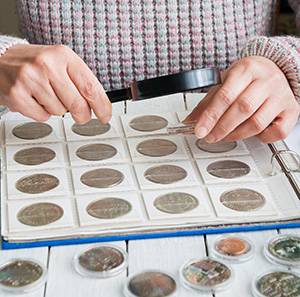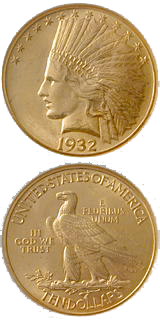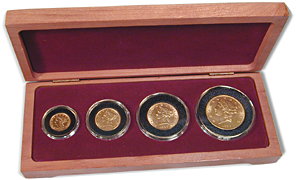The Experts Guide to Collecting and Investing in Rare Coins Review
Coin Collecting for Turn a profit
Inside This Report
- Coin Collecting vs Coin Investing Investors
- Reasons for Appreciation
- Six Categories of The states Coins
- How Rare Coins Are Classified
For over ii,000 years, coins struck in silver and gold have been among the nigh pop forms of money ever created. From the early days of Greek and Roman coinage, Europeans have traded with gilt coins and argent coins. Ancient Coins were too struck in silver and "base" metals like bronze and copper. Nevertheless, aureate coins, considering of its intrinsic value, have historically been the most popular medium for commutation.
Today, the Usa Mint reports in that location are 125 one thousand thousand coin collectors in the United States. This number is up dramatically from 20 million believed to collect coins a decade agone. In improver to The states coin collectors, there are millions of other money collectors around the globe! In fact, coin collecting is widely recognized equally one of the near rewarding hobbies. While it was once known exclusively as the "the hobby of kings" due to the high cost of coins, today coin collecting is for people of all ages. Today young collectors to seasoned gold investors who focus on rare gold coins equally collectibles are plentiful.
From Money Collecting to Coin Investing

Throughout history, many coin collections have produced substantial profits for their owners. This is particularly true for coin collectors of this century. Harold Bareford reportedly purchased a collection of US gilt coins for $xiii,832 in early 1950s which was resold at auction in 1978 for $1.2 million. This is merely i of many anecdotal examples of how assisting rare coin collecting has become.
Historically, the financial support for the Us Rare Money market place came from money collectors who bought coins for their beauty and historical significance. All the same, substantial profits realized by owners of rare coin collections in the 1970'southward and 1980's moved coin collecting from being more than just a hobby as many investors began collections targeted at generating long-term profits.
Austin Rare Coins & Bullion would like to remind prospective money buyers to exist aware that there are many different ways to collect coins. Some money collections are congenital but for the fun of information technology while other other collections are built with the goal of creating long-term wealth and profits. Go on in mind that by performance is non a guarantee of future results. Not every investor'south rare coin portfolio volition enjoy verbal results of another.
Reasons for Appreciation
While collectors view their coins as fine fine art and as tangible remnants of the cultural and economic forces that created them, investor interest is prompted by the fact that coins of proven rarity have shown high rates of appreciation. However, the line between the collector and investor often becomes blurred. Collectors tin't aid but exist pleased when coins they sell bring a profit. Investors begin to run across their coins as works of art to concur onto. Investors also study the history and become knowledgeable about a coin for future prosperity and return on investment.
Both investors and collectors come up to realize the importance of value. Intellectual curiosity, aesthetic sensibilities, and enjoyment tin can plough into a valuable endeavor that leads to wealth that can be seen as a lucrative portfolio of coins.
Bullion Coins
Investors have too get significant buyers of bullion coins like American Eagles and Canadian Maple Leafs. These gilded coins are official legal tender coins created for the purpose of precious metals investment. Since the ban on gilded ownership by Us citizens was lifted in late 1974, millions of Americans have added gold, silver, platinum, and even palladium coins into their investment portfolios.
Financial advisors recommend investments in precious metals every bit an important part of portfolio diversification. Information technology serves every bit a reliable hedge against inflation and also serves as an enduring storehouse of value for the long term.
Six Major Categories of Usa Coins
Usa coins minted prior to 1965, and particularly coins minted prior to the 1933 ban on Gold, have proven to exist among the most popular and lucrative areas of US rare coins. While profiling all United states of america coins would be enough to fill a book we will endeavour showing the nearly commonly purchased Us rare coins for investing and collecting. Here are six key areas that are popular today:

US Gold Coins – Coins minted earlier 1933, including Pre-Civil State of war and Ceremonious War Era Gold Coins.
19th Century & Earlier Type Coins – This would include coins minted from the tardily 1700's through 1899.
Silver Dollars – Morgan Silver Dollars from 1878-1921 and Peace Argent Dollars issued from 1921 to 1934.
Commemoratives – Coins specifically struck in low mintages to commemorate historic events.
20th Century Blazon Coins – Before 1965, this would include silverish dimes, silver quarters and nickels, pennies, and modern issues created for circulation by the public.
Current Issues – The Statehood Quarters, Sacagawea Gold Dollars, Buffalo Silvery Dollars, and all circulating coins y'all tin can get at any local bank would exist current issues.
Why Are Some Coins "Rare"
Most coins that are deficient today started out as common problems struck in large quantities past the US Mint. Even though thousands or even millions of copies of a detail coin were originally minted, later many decades, the vast majority were worn out in apportionment, lost, or destroyed. As a consequence, these remaining coins in pristine condition have become rarer and harder to find over time.
Other coins were minted in very small quantities to begin with. This grouping of coins includes older proof problems, exam strikes, pattern coinage, and fault coins. Notwithstanding, rarity refers to more than but the number of coins in existence. It is besides a function of investor/collector demand for the coin. If a coin is said to be rare or scarce, it implies that the available quantity is small relative to the current or expected demand for the money in the marketplace.
How Rare Coins Are Classified
As with any investment or collectable, the value of a rare coin is established in a free market place by supply/demand. The size and intensity of need is influenced past these criteria:
- The value of the coin's precious metals' content.
- Its rarity, scarcity or collector value.
- A coin'southward demand factor among collectors and investors.
- Finally, in that location'south each individual coin's center appeal and state of preservation.
Here'south a brief discussion of each of these factors:
- Eye entreatment is afflicted by many things
- The dazzler of a coin pattern.
- The minting process used.
- The fullness and sharpness of its strike.
- The brilliance of its luster.
- The number of scratches or nicks on the coin's surface.
- The amount of wearable on the coin'south raised areas.
Understanding Coin Grading
As far every bit quality is concerned, numismatic coins always fall into one of two bones conditions. Either they are circulated coins- coins that exhibit wear- or they are uncirculated coins. The ANA has endorsed a grading scale that divides circulated and uncirculated coins into 24 distinct coin grades. In that location are 13 circulated grades and 11 uncirculated grades.
The lowest uncirculated form is MS-60, while the highest is MS-70. The "MS" stands for Mint Land. In betwixt, at that place are grades MS-61, MS-62, MS-63, and so on, all the fashion up to MS-lxx-a perfect money. Each step up the grading calibration indicates an comeback in quality, rarity, and usually a dramatic difference in the coin's price.
Portfolios, Collections, and Sets

Today, the distinction between collectors and investors has become blurred. This is considering investors accept learned that the qualities of outstanding coin collections also produce outstanding portfolios. Many kinds of collections offering the same range of diversification that would exist provided in a pure investment
portfolio. An investor should follow the same methods as a collector in formulating a strategy, buying coins carefully over a menstruation of years, holding them for the long term, and and then liquidating them when an appropriate opportunity presents itself when prices are high.
Possibly the most popular and rewarding portfolio strategy, is set building. The two basic forms of collections are "type" and "series." A blazon set is made up of all those coins sharing a unmarried, specific characteristic such as design, designer, or denomination. A serial consists of ane coin from each appointment and mint of a particular blazon. Other strategies include collecting past die variety, by historical period, by mint mark, or past private twelvemonth or first and last twelvemonth of issue of a particular coin.
Source: https://www.austincoins.com/coin-collecting-for-profit
0 Response to "The Experts Guide to Collecting and Investing in Rare Coins Review"
Postar um comentário